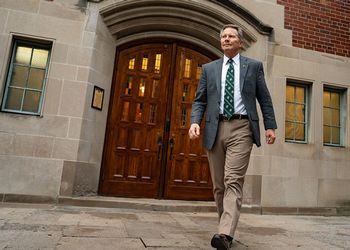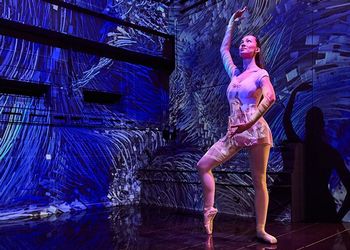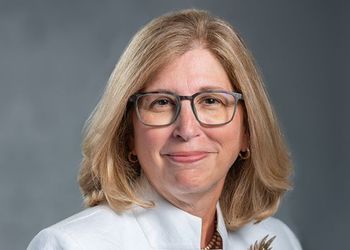Feature: A Commitment to Education and the Arabian Horse

MSU’s beautiful horses serve as elegant ambassadors for the university and its agrarian heritage.
The short drive along Collins Road toward MSU’s main campus often rewards passersby with a pastoral view of purebred Arabian horses and high-spirited foals gamboling beneath the shade trees of the Horse Teaching and Research Center (HTRC).
The beauty of these regal horses has made the farm a popular destination for campus visitors. The more than 90 horses that comprise MSU’s herd—including 20 Arabian broodmares, 4 stallions and 17 purebred foals—are elegant ambassadors for MSU and evocative of the university’s agrarian heritage.
Horses have been a part of the MSU tradition since the institution’s founding 150 years ago. Horses helped clear land, plow fields, haul loads and provide transportation for students and faculty in the early years of Michigan Agricultural College.
The university’s involvement with horses grew to include improvement of working horses, as purebred breeding programs were established in the early 1900s for Clydesdales (1907), Percherons (1908) and Belgians (1918). Michigan State College’s breeding program was tremendously successful. Between 1910 and 1930, its draft horses won 211 firsts and 155 championships at state fairs and international competitions. The university’s draft horse stable was considered the “best collegiate stable in America,” according to Draft Horse Journal publisher Maurice Telleen.
Following WWII, however, mechanized horsepower replaced draft horse power, and the draft horse program dwindled. By 1963, the last of MSU’s draft horses had left the university—a hiatus that lasted 36 years, until Ilona and Mark Stewart donated a team of Belgian draft horses to MSU in 1999. By the 1960s, MSU’s horse program faced extinction.
“If it were not for John Hannah, we would not have horses on campus today,” says John Shelle, director of the MSU Horse Program.
As the university downscaled the draft horse program during the 1950s, most of the horses on campus were sold. According to Shelle, President Hannah insisted on maintaining a small herd of horses on the farm, to keep students in touch with the university’s equine roots.
“If we had gotten completely out of the horse business, we would never have been able to reestablish it,” Shelle added.
Fortunately for the horse industry, and anyone who appreciates the beauty of high quality horses, MSU managed to preserve its program through those difficult times.
Just as the university’s draft horse program had reached its zenith, MSU’s Arabian breeding program was launched in 1934 with the donation of the stallion Amidore by cereal tycoon W.K. Kellogg. In the beginning, Amidore was used to add some of the desirable characteristics of the Arabian horse to the local stock and larger draft horse breeds.
Purebred Arabian mares arrived on campus in March 1942, and were bred to Amidore that spring. The first crop of foals, in 1943, marked the beginning of MSU’s Arabian horse breeding program, recognized as the third-oldest continuous program in North America. Only the Kellogg Ranch at California State Polytechnic University, Pomona, and Al-Marah Arabians, in Tucson, Arizona have been established longer.
The university soon developed a reputation as a leading producer of high quality Arabian purebreds. In 1961, MSU became home to the Egyptian horse, *Ghalii, a gift from the United Arab Republic of Egypt to then U.S. Secretary of Agriculture Ezra Benson. *Ghalii introduced quality and name recognition to the MSU breeding program through the successful show horses he sired.
While the showy stallion was tremendously popular, particularly with fans of straight Egyptian Arabians, MSU’s most significant import of 1961 was a mare named *Silfretta. Professor Byron Good, who served as the first director of the MSU Arabian breeding program, purchased *Silfretta in Canada, where she had been named a Reserve Champion Mare at the Royal Winter Fair in Toronto. *Silfretta was a product of the famous Crabbet Stud farm in England, and was that country’s 1956 champion yearling filly. She produced 11 foals during her 23 years at MSU, and her genetics run throughout the current herd. MSU’s “S” family of horses, all descendents of *Silfretta, is its most successful line.
Dr. Good built the university’s Arabian horse breeding program by adding the genes of exceptional Polish Arabian sires to MSU’s high quality mares. He sent several of the university’s top mares to be bred to *Bask, the 1964 National Champion stallion. Among the resulting offspring was a horse that would become MSU’s most influential mare, Easter Basket.
“Easter Basket figures into everything that amounts to anything here.” John Shelle noted succinctly.
Born on Easter Sunday 1967, the roan mare Easter Basket lived up to the promise of her name. She was an aristocrat mare, meaning she produced four champions among her 16 offspring. Two of her daughters also became aristocrat mares, and five of her daughters have produced champions. She was grandmother to Pask, the most significant stallion ever bred at MSU.
“We’re proud to have a lot of national winners out of MSU,” Shelle said. “But, we generally sell the horses when they are young and let others put in the money and time it takes to train a horse to be a champion.”
Despite the distinguished pedigrees and growing list of champions that have resided at MSU, Shelle considers the most important aspect of the Arabian program to be its usefulness as a teaching tool.
“Our breeding program exists to support our teaching, research and extension programs,” he noted. “We maintain the highest quality livestock on our farms because our students need to learn to recognize quality. For students to recognize high quality characteristics, they need to work with high quality horses. If students learn on average livestock, that mediocrity breeds mediocrity and that mediocrity soon becomes the acceptable norm.”
Indeed, the addition that has had a more enduring effect on the MSU Horse Program is undoubtedly Shelle himself.
When John Shelle came to MSU as an undergraduate student in 1970, there were 35 horses on the farm, but no horse courses and no student involvement with the horse-breeding program. When he became farm manager in 1973, while still an undergraduate student, he convinced his mentor, Byron Good, to allow students to work with horses.
“We almost blew it that first year,” Shelle recalled. “A student was working with one of our most beautiful horses, Desert Cross, and she put her leg through a fence. That ended her show career – although she went on to produce some of our most famous horses. It almost ended our student program.”
Shelle convinced Good that mistakes were to be expected in a teaching program, and that they would make the farm work as a teaching laboratory. A few years later, Shelle’s instincts proved true. In 1979, the program produced a very successful weanling colt that was undefeated in show. Nu Biisk was foaled by students, shown by students, and marketed by students—selling for $10,000, a huge sum at the time for a weanling colt.
“It proved that we could do it with students and keep the operation financially viable,” Shelle recalled.
Today, Shelle directs the horse program and Paula Hitzler is manager of the farm—a position that Shelle describes as the best job on campus. Hitzler oversees the facilities, and supervises up to 12 student employees who are responsible for the day-to-day care and management of the breeding herd and facility. She also directs student involvement in all breeding, foaling, training and handling, and most horse sales. The students are engaged in every aspect of the farm. A student intern even assists in the management of the reproductive program.
“We have huge teaching, research and Extension commitment,” Shelle said. “We try to keep the experience as close as possible to what students will experience after they graduate. Our primary mission is to educate the next generation of Michigan horse persons and to engage in research to find solutions to industry problems.”
The majority of MSU’s horse classes, in both the 4-year Animal Science Equine Program and the 2-year Agricultural Technology Horse Management Program, are taught at the HTRC. Many adult and youth Extension programs are also offered at the farm. The HTRC maintains strong ties to research programs of the College of Agriculture and Natural Resources and the College of Veterinary Medicine, housing several ongoing projects of the Equine Research Lab.
The 100-acre farm, located four miles south of campus, includes four barns, a breeding shed, storage shed, indoor arena and classroom complex. The facility was expanded in the 1990’s with state funds earmarked for advancing Michigan’s animal industries. This Animal Industry Initiative also paid for construction of the MSU Pavilion and numerous improvements to animal science and veterinary medicine programs and facilities across campus. The show/training barn, completed in 1995, houses show and sales horses as well as those being used in classes. The stallions occupy the oldest structure on the farm – their six stalls (in the short aisle of the breeding barn) were from the original horse barn built on campus in 1855 and relocated from Farm Lane to Collins Road when the farm moved south. The newer, long aisle of the barn houses mares and foals during the breeding season.
The HTRC is open to the public from 8 a.m. to 5 p.m. daily, and receives a steady stream of visitors seven days a week. Signage throughout the farm facilitates self-guided tours for the free roaming guests that wander through barns and pastures. Students are also available to answer questions about the horses and operation. The farm is a popular destination for school and daycare groups as well as individuals and families drawn to the sight of the curious foals, nurturing mares, and athletic show horses that populate the HTRC pastures.
“On a slow day we get 50 to 100 visitors,” Shelle said. “It’s a wonderful place to bring a group of young people, sit on a blanket under the trees and watch the foals.”
The education programs at the farm are equally popular. Demand continues to exceed available spaces – especially within the two-year and continuing education programs. The two-year certificate program in Horse Management offered through the Institute for Agricultural Technology emphasizes both theory in basic nutrition, physiology and breeding, and hands-on learning. A mandatory internship in their final semester provides these students with experience that ensures they will be well prepared for successful careers. Graduates of the “Ag Tech” program excel in a wide variety of careers as trainers, riding instructors, show grooms, exercise riders, and employees and owners of boarding facilities and breeding farms.
The four-year program leading to a Bachelor of Science degree, offers three major education tracks. Students can emphasize science, agri-business management or pre-veterinary medicine. Course work, directed studies and undergraduate research projects allow students to focus on areas that meet their individual interests. The extremely popular basic and advanced draft horse driving classes are examples of the unique learning opportunities offered. Study abroad programs in Ireland and Northern Ireland, and a semester exchange with the horse program of Enniskillen College of Agriculture in Northern Ireland expose students to different systems of horse management. Students also participate in internships with leading equine operations throughout North America, Mexico, Australia, England, Germany and Poland.
Graduate programs in equine science are available at both the Masters and Doctoral level. Students conduct research and are encouraged to become involved in teaching and extension activities.
A highlight of the undergraduate programs is the annual Spartan Spectacular Sale, held each April. Every aspect of this horse sale – from the preparation of the horses to event promotion and even concessions – is planned and implemented by students under the direction of Shelle and Hitzler. This year, the highly successful event brought more than 250 spectators and 57 registered buyers to bid on 14 horses – horses that sold for an average of more than $4,000 each.
Another popular extracurricular experience is the collegiate judging team. The MSU Senior team has been named high team overall in the U.S. Arabian National Youth Judging Contest six times since 1988, with an unprecedented three consecutive victories from 1998-2000.
The opportunity to train and show MSU Arabians on the Class A show circuit provides yet another student enrichment experience. In 2003, MSU horses shown by students won Top 10 National honors for the first time. MSU Shagadelic was selected a “National Top Ten Sport Horse Mare in Hand” and MSU Shake It Up was named a “Top Ten Sport Horse Under Saddle.” MSU Shake It Up and MSU Shagadelic were shown respectively by students Emily Townsend and Emily Devers, who were both sophomores at the time. In addition, MSU Magic J, owned and shown by Dr. Hilary Clayton, the McPhail Dressage Chair in the College of Veterinary Medicine, has won US National Champion honors in both Second Level and Third Level Dressage.
The progeny out of the MSU Arabian breeding program includes a long list of national and international performance champions. Under the expert direction of first Byron Good and then John Shelle, the Arabian breeding program has continued to produce the highest quality livestock possible – world-class athletes with the dispositions needed for use in an educational environment with significant student interaction. Each Spring, a new crop of wobbly foals emerges – reflecting their noble 62-year heritage and beginning new chapters in the pedigree of MSU’s horse program, much to the delight of dedicated horse people and casual observers alike.
Francie Todd, '80, is communications manager for MSU's College of Agriculture and Natural Resources. She lives in East Lansing with her husband, Jay, and two children, ages 7 and 9. Unfortunately, their backyard is too small for horses.
A COMMITMENT TO EQUINE EXCELLENCE
MSU’s involvement with the horse industry extends well beyond the Horse Teaching and Research Center. Faculty members in both the Dept. of Animal Science and the College of Veterinary Medicine are internationally recognized for their work in fields that include nutrition management, genetics, exercise physiology, animal behavior and welfare, and a wide range of specialties focused on every aspect of equine health, development and performance.
Research Expertise and Facilities:
- The Diagnostic Center for Population and Animal Health(website: http://www.ahdl.msu.edu/), under the direction of Dr. Willie M. Reed, offers a comprehensive, state-of-the-art facility for diagnosis of sickness or cause of death of companion animals, livestock and wildlife. New facilities, opened in September 2004, serve as Michigan's official diagnostic laboratory, providing animal health services not only to state government, but to veterinarians, companion and farm animal owners across Michigan.
- The Equine Foot Laboratory (cvm.msu.edu/research/efl), under the direction of Dr. Robert M. Bowker, focuses on the biomechanics of the joints and bones of horses.
- The Equine Pulmonary Laboratory(cvm.msu.edu/research/pulmon), directed by Dr. N. Edward Robinson, the Matilda R. Wilson Professor, investigates the pathogenesis and treatment of diseases of the airways of the horse. The Laboratory for Comparative Orthopaedic Research(LCOR) (cvm.msu.edu/lcor), focuses its research on sports related injuries to both humans and animals. Dr. Steven Paul Arnoczky, the Wade O. Brinker Endowed Professor of Surgery in the College of Veterinary Medicine, directs the lab.
- The Large Animal Teaching Hospital, under Dr. John Stick, Chief of Staff, offers both emergency care and services by appointment. The hospital also provides advanced training for veterinary medicine students, and postdoctoral education to professionals involved in large animal health. The facility also houses the Clinical Pathology Laboratory, providing state-of-the-art diagnostic testing.
- The Mary Anne McPhail Equine Performance Center (cvm.msu.edu/dressage), houses the McPhail Dressage Chair research group and provides a state-of the art lameness evaluation facility and a farrier center. Dr. Hilary M. Clayton serves as the McPhail Dressage Chair. Her studies on the biomechanics of equine gait have focused on sport horses, including dressage and jumping horses. Dr. Clayton is active in the sport of dressage at the highest levels and is a certified equestrian coach in both the UK and Canada.
- The Molecular Respiratory and Equine Genetics Laboratory (cvm.msu.edu/research/mregl), directed by Dr. Susan Ewart, works to determine the molecular mechanisms of inherited diseases in the horse, and to understand the genetic predisposition to respiratory tract diseases in all species.
Student Involvement:
A hands-on approach to learning is required of students in both veterinary medicine and animal science horse programs. In addition to formal laboratory and field work required in their majors, students participate in clubs and associations that invigorate their interest in horses.
- The Horsemen's Association, a student organization that promotes involvement with the horse industry, hosts guest lectures, field trips, clinics horse shows and other industry activities. The group also provides support to the MSU Equestrian Team, Polo Club and Horse Judging Team.
- The MSU Rodeo Club, established in 1969, annually hosts the Spartan Stampede Rodeo. The club is a member of the National Intercollegiate Rodeo Association (NIRA) and sends a competing rodeo team to NIRA rodeos in the Ozark Region.
- The Block & Bridle Club promotes all areas of animal agriculture and offers students opportunities to show and sell livestock in club sponsored events.
- The CVM Equine Club and Student Chapter of the AmericanAssociation of Equine Practitioners exposes veterinary and veterinary technology students to practice beyond their traditional curriculum. Members of the group participate in “wet labs” that provide invaluable hands-on experience. Veterinary medicine students gain both social and educational benefits through a variety of interest-oriented student organizations including student chapters of the American Animal Hospital Association and the American Veterinary Medical Association, the Pathology Club, the Veterinary Practice Builders Association, and Omega Tau Sigma professional veterinary fraternity.
- The CANTER Program: A unique outreach program involving students studying equine veterinary medicine, is a collaboration with CANTER (the Communication Alliance to Network Thoroughbred Ex-Racehorses) to provide care to retired racehorses. CANTER is a nonprofit organization dedicated to placing Thoroughbred racehorses with non-race homes after retirement. Since 1999, MSU College of Veterinary Medicine faculty members and students have provided donated arthroscopic surgery to remove bone fragments from joints or to repair fractures of retiring horses owned by the CANTER program. MSU also provides other forms of surgery, clinical examinations, evaluations, diagnostic testing and other procedures for these retired Thoroughbred horses, enabling them to live healthy and productive lives once their racing careers have ended.
A TRADITION OF GIVING AND PERSONAL INVOLVEMENT
The MSU horse program is built on a tradition of industry and individual support. From the initial Kellogg donation of Amidore (in 1934) and the Arabian mares (in 1942), and the 1961 acquisition of the Egyptian horse *Ghalii, MSU’s Arabian breeding program has benefited greatly from donor horses and donated breedings. Such gifts have infused the MSU herd with the genetics of superlative stallions and excellent mares for more than 60 years.
Donated breedings allowed MSU to participated in many stallion syndicates during the 1970’s and 80’s, including National Champion stallions *Aladdinn and MS Santana, and National Champion park horses Cognac and *Napitok. Today, donated breedings continue to enhance MSU’s Arabian lines. Ohadi Ben Rabba, a stallion that stood at stud at MSU from 1998 to 2001, produced champion quality offspring and continues to strengthen the MSU herd through his daughters’ genetics.
In 1990, MSU acquired much of the herd of food service entrepreneur John Gordon’s predominantly Polish-bred Arabians. Two years later Claire Morzoff donated her entire herd of Cedardell-bred Arabians to MSU. MSU’s “C” family of Arabians is descendent from these Cedardell horses.
Other horses that have come to MSU as gifts have made considerable contributions to equine programs on campus.
Lynette and Richard Merillat donated the 80-acre Merillat quarter horse farm to MSU in 1997, establishing “The Merillat Equine Center”. The gift included the property, facilities and 43 quarter horses, including two premier stallions.
Draft horses were reintroduced to MSU through the donation of a team of Belgians from Ilona and Mark Stewart in 1999. Although one of the geldings died from cancer shortly after his arrival and was replaced with a team purchased by MSU (Coronel and Duke), the donor horses made the popular draft horse program possible. In 2000, Dan Creyts donated two pregnant Belgian mares, Greta and Flora. Their fillies, MSU Millennium and MSU Memory, were sold as yearlings, helping to ensure that the draft horse program will continue for years to come.
A grant from the Irwin Foundation enabled MSU to obtain three Andalusian horses, Go Green!, Go White! and Go Spartans!. These beautiful white horses, purchased by the College of Veterinary Medicine in 2001, used to pull the Spartan chariot at MSU football games and other events.
Equine research, outreach and teaching programs within the College of Veterinary Medicine have benefited enormously from privately endowed faculty positions, including the Matilda R. Wilson Professor, the Wade O. Brinker Endowed Professor of Surgery and the McPhail Dressage Chair. The Mary Anne McPhail Equine Performance Center, a state-of-the-art facility for training, diagnosing health problems and studying the locomotion of sport and performance horses, was also built through private support. Individuals and industry have also provided countless opportunities for students through endowed scholarship and fellowship grants.
HTRC Director John Shelle’s goal is to make the MSU horse program self-supporting over time. An endowment is being established to ensure that programs can continue in perpetuity. A new association, Friends of the Horse Teaching and Research Center, was recently created to support educational opportunities for students within the equine program. Membership dues support the HTRC Enhancement Fund to help finance activities directly related to teaching. In addition to student programs, the fund will support continuing education and outreach such as clinics, workshops and an electronic newsletter. Friends of the HTRC will encourage its members to participate in volunteer activities, including an annual fund-raising horse show for the HTRC.
For information on the Friends of the HTRC, contact John Shelle or Paula Hitzler at MSU Horse Teaching and Research Center, 1250 Anthony Hall, Michigan State University, East Lansing, MI 48824 (517-355-7484).



